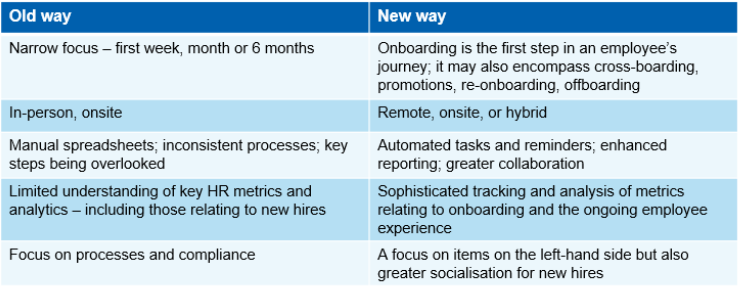When the world was thrown into lockdown just over 12 months ago, few could have predicted just how extensively our working lives would be impacted. If nothing else, it has also provided employers with a rare opportunity to re-assess and recalibrate their existing people-related policies and processes.
Before making any changes to your onboarding processes, it’s important to understand both how and why things may need to be updated. We’ll explore both in this blog.

Why has onboarding changed?
Even before COVID-19 turned our world upside down, there were some big changes happening with onboarding. It was clear there were some flaws with the traditional way of onboarding new hires. Here are just a few of those change-drivers.
- The global pandemic – We can’t ignore COVID-19. It has impacted just about every aspect of talent management, and onboarding is no exception. For one thing, employers and new hires alike have had to adapt to onboarding from remote locations – often from people’s homes. That has changed how we communicate with people, how we socialise new hires into the company, and how we share important information with them.
- The turnover rate of new hires is high – 2018 research from recruiter Robert Half shows that 60% of Australian hiring managers have had an employee resign during their probation period, and 43% lost the new employee during their first month. According to ELMO’s 2021 HR Industry Benchmark Report, it costs $10,500 on average to fill a vacant position and it takes over 33 days to fill a vacant position. If that new hire walks out the door early in their career with you that’s a lot of wasted time and money.
- We’ve also become more aware of how important onboarding is in terms of the overall employee experience. It’s the start of an employee’s journey with an organisation and is critical because of that – we all remember our first days in a new job, good or bad!
- We can also say that employee expectations have changed. The employer-employee relationship has shifted. It’s no longer good enough to drip feed information to employees on a need-to-know basis only. An all size-fits-one approach no longer cuts it; personalised onboarding experiences are the order of the day. Employees want more say in their career paths, how and where they work, their professional development – and yes, their onboarding experience.
How has onboarding changed

So, now we’ve outlined why onboarding has changed, let’s explore how it has changed. The table below shows old and new perceptions of onboarding and what it encompasses:
- Firstly, the scope has widened. Onboarding is the first step in an employee’s journey; it may also encompass cross-boarding, promotions, and re-onboarding – To put it plainly, onboarding is more than you might think. Sure, the focus is still on those critical early weeks and months of employment, but it also now applies during important transition moments for employees. It may be that they’ve started a new role in a different part of the business. It may be that they’ve been promoted to a new role in the same department. It may be that they are returning from parental leave. All of these transitions require a slightly different approach. You’ll also find that this doesn’t just fall to HR – it’s a collaborative effort for team members across the organisation.
- It now needs to encompass remote workers, or be done onsite, or be a mix of both (i.e. hybrid). – This is a major shift. Today, we need to be able to onboard employees no matter where they are based. For some this will be an entirely remote experience. For others, it will be purely onsite. And for others it will be a mix of both. Regardless, we need to ensure we’ve got our traditional paper-based forms digitised and that we’re giving new hires the right information at the right time.
- It now needs to encompass sophisticated tracking and analysis of metrics relating to onboarding and the ongoing employee experience – HR in general has been criticised for not ‘knowing the numbers’, for relying too heavily on ‘gut instinct’. Today, thanks to technology, it’s easier to gather and analyse important metrics relating to the employee experience. Key statistics such as new the hire turnover rate, employee performance milestones being met, and impact on team morale/culture can be easily obtained and tracked, and they provide invaluable insights into your internal processes. They allow you to constantly refine each part of the onboarding process.
- Today it needs to focus not just on processes and compliance, but also greater socialisation for new hires– Of course, getting the processes and compliance side of onboarding is critical. That has not changed. However, a relatively new element is ensuring your new hires get to know their fellow team members and the wider workforce. That might be a mix of physical events (e.g. morning teas for new hires with key staff members), or virtual events via Zoom or Teams (e.g. inviting everyone who’s new to find out more about everything the employer offers – e.g. run clubs, book clubs, movie nights, etc. Make it fun and get creative!
There’s never been a better opportunity to reimagine all aspects of talent management – and onboarding should be top of the list. Keen to know more? Get in touch with HROnboard below!
ELMO Software offers end-to-end solutions for the entire employee lifecycle, from ‘hire to retire’. This includes recruitment, learning, performance management, payroll, rostering / time & attendance, and more. For further information, contact us.
